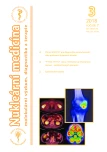-
Medical journals
- Career
The benefit of SPECT/CT in the diagnosis of osteochondral lesions of knee joints
Authors: Milan Šimánek
Authors‘ workplace: Oddělení nukleární medicíny, Nemocnice Pelhřimov p. o., ČR
Published in: NuklMed 2018;7:42-49
Category: Original Article
Overview
Introduction:
The bone scintigraphy and other more complex examinations are recomended for patients with knee joints damage, whose symptoms do not match findings of simpler imaging methods (especially based on radiographs) and laboratory methods.
Purpose:
The aim of the study was to evaluate the benefit of SPECT/CT examination in the diagnosis of avascular necrosis, osteochondrosis dissecans and other osteochondral lesions of knee joints. To compare the main clinical findings, X-ray findings and results of SPECT/CT. To assess the benefits of the availability of the hybrid system in routine practice.
Materials and methods:
The data of 38 patients, with 45 affected joints from the years 2007–2017 (mean age 60 ± 17 years, 57 % of women) who underwent bone scintigraphy with regional SPECT and separately CT until 2014, then with hybrid SPECT/CT, were retrospectively evaluated.
Results:
Pain (87 %) and swelling of the knee (21 %), pain in hips and spine (13 %) dominated in clinical findings. Secondary diagnosis was gonartrosis in 58 %, trauma in 16 %, prostate cancer or breast cancer in 16 %. Radiography was suspected in 36 % only before SPECT examination. Bone scintigraphy was positive in 96 % of cases. A blood pool was positive in 80 % of cases. According to CT results we found an osteochondral defect in 67 %, osteochondrosis dissecans in 20 %. We observed early stage of the joint damage in 9 % and early condyle osteonecrosis in 4 %. The number of discovered pathological findings increased to six times after the introduction of the SPECT/CT hybrid system into clinical routine practice.
Conclusions:
Early condyle osteonecrosis, osteochondrosis dissecans, osteochondral defect and the „atypical“ degenerative changes of the knee joints based on only clinical symptomatology or radiography cannot be distinguished. Hybrid SPECT/CT is an appropriate investigative method for these diagnoses. It improves patient management and treatment planning.
Key Words:
knee, SPECT/CT, chondral lesion, osteonecrosis
Sources
- Van den Wyngaert T, Strobel K, Kampen W et al. The EANM practice guidelines for bone scintigraphy. Eur J Nucl Med Mol Imaging 2016;43 : 1723–1738
- Agarwal K, Mukherjee A, Sharma P et al. Incremental value of 99mTc-MDP hybrid SPECT/CT over planar scintigraphy and SPECT in avascular necrosis of the femoral head. Nucl Med Commun. 2015;36 : 1055-1062
- Mujoomdar M, Russell E, Dionne F et al. Optimizing Health System Use of Medical Isotopes and Other Imaging Modalities [online]. Ottawa (ON): Canadian Agency for Drugs and Technologies in Health; 2012. [cit. 2018-02-09]. Dostupné na: https://www.ncbi.nlm.nih.gov/books/NBK174872/
- Saha S, Burke C, Desai A et all. SPECT-CT: applications in musculoskeletal radiology. Br J Radiol. 2013;86 : 20120519
- Dordevic M, Hirschmann MT, Rechsteiner J et al. Do Chondral Lesions of the Knee Correlate with Bone Tracer Uptake by Using SPECT/CT? Radiology 2016;278 : 223-231
- Karim A, Cherian J, Jauregui J et al. Osteonecrosis of the knee: review. Ann Transl Med 2015;3 : 6. [online] [cit. 2018-02-09]. Dostupné na: http://atm.amegroups.com/article/view/5308
- Koh G, Hwang KH, Lee H et al. Correlation of Uptake Patterns on Single-Photon Emission Computed Tomography/Computed Tomography (SPECT/CT) and Treatment Response in Patients with Knee Pain. Nucl Med Mol Imaging 2016;50 : 137-143
- Maas O, Joseph GB, Sommer G et al. Association between cartilage degeneration and subchondral bone remodeling in patients with knee osteoarthritis comparing MRI and (99m)Tc-DPD-SPECT/CT. Osteoarthritis Cartilage 2015;23 : 1713-1720
- Hirschmann A, Hirschmann MT. Chronic Knee Pain: Clinical Value of MRI versus SPECT/CT. Semin Musculoskelet Radiol 2016;20 : 3-11
- Dordevic M, Hirschmann MT, Rechsteiner J et al. Chondral Lesions of the Knee Correlate with Bone Tracer Uptake by Using SPECT/CT. Radiology 2016;278 : 223-231
- Ro du H, Lee HY, Chang CB et al. Value of SPECT-CT Imaging for Middle-Aged Patients with Chronic Anterior Knee Pain. BMC Musculoskelet Disord 2015;16 : 169
- Luk WH, Au-Yeung AW, Yang MK. Diagnostic value of SPECTversus SPECT/CT in femoral avascular necrosis: preliminary results. Nucl Med Commun 2010;31 : 958-961
- Al-Nabhani K, Michopoulou S, Allie R et al. Painful knee prosthesis: can we help with bone SPECT/CT? Nucl Med Commun 2014;35 : 182-188
- Niccoli G, Mercurio D, Cortese F. Bone scan in painful knee arthroplasty: obsolete or actual examination? Acta Biomed 2017;88 : 68-77
- Saltybaeva N, Jafari ME, Hupfer M et al. Estimates of effective dose for CT scans of the lower extremities. Radiology 2014;273 : 153-159
- Elgazzar AH. Orthopedic Nuclear Medicine - 1st edition. Berlin, Springer Berlin 2004, 240 p
- Staging of Avascular Necrosis. OrthopaedicsOne Articles. OrthopaedicsOne - The Orthopaedic Knowledge Network. Created Feb 20, 2009 17 : 25. Last modified Feb 22, 2009 08 : 58 ver.6. [online] [cit. 2018-02-09]. Dostupné na: https://www.orthopaedicsone.com/x/A4AqAQ.
- Bui-Mansfield LT. Osteochondritis Dissecans Imaging. [online]. Updated: Dec 29, 2015. [cit. 2018-02-09] Dostupné na: https://emedicine.medscape.com/article/392396-overview
- Weerakkody Y, Gaillard F. Osteochondral defect. [online] [cit. 2018-02-09]. Dostupné na: https://radiopaedia.org/articles/osteochondral-defect
Labels
Nuclear medicine Radiodiagnostics Radiotherapy
Article was published inNuclear Medicine

2018 Issue 3
Most read in this issue- The benefit of SPECT/CT in the diagnosis of osteochondral lesions of knee joints
- 18F-FDG PET/CT pattern of Erdheim-Chester disease – a group of Czech patients
- LYMFOSCINTIGRAFIE provedení vyšetření a jeho interpretace
- 55. DNY NUKLEÁRNÍ MEDICÍNY
Login#ADS_BOTTOM_SCRIPTS#Forgotten passwordEnter the email address that you registered with. We will send you instructions on how to set a new password.
- Career

